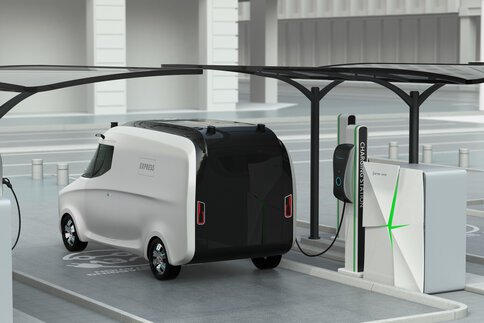Sustainable mobility concepts for city logistics
Vehicle manufacturers, rental companies and logistics providers offer numerous solutions for clean and efficient city supply. Read more about sustainable mobility concepts of the future and why they are indispensable for logistics.
In 2022, 4.15 billion parcels were delivered in Germany. According to a report by the German Parcel and Express Logistics Association (BIEK), the industry has again demonstrated its importance to society as a whole and is making massive investments for the future.

Wanted: alternative mobility concepts
Eco-friendly city logistics is not just about drive technologies for vehicles. All stakeholders are working together to develop sustainable mobility concepts aiming for low-emission and efficient city center logistics. BIEK summarized the neuralgic points in a memorandum of understanding back in 2018. This issue is as relevant as before and the need for action is high—particularly for electromobility, delivery zones and micro-depots.
Sustainable urban logistics with many stakeholders
Logistics companies, CEP providers and municipalities are discussing the organization of the last mile and the issue of sustainable logistics in urban areas. Examples of sustainable traffic concepts will be featured throughout the forums at transport logistic. It is about vehicles, route planning, goods handling and overall strategies for emission-free and city-compatible delivery traffic.
Sustainable mobility in urban areas
The search for environmentally friendly solutions for city logistics is not only about nature conservation and health; economic interests such as gaining market share and customer loyalty also play an important role. That's good news for the people in cities: aligning economic and ecological goals significantly accelerates the search for the mobility concepts of the future.
BIEK Chairman Marten Bosselmann wishes for better conditions for delivery traffic and shares his thoughts on the decision to amend the Road Traffic Act: “The Federal Council opted against creating improved conditions for all delivery traffic. Cargo areas have the potential to drastically reduce emissions in urban traffic.”
Practical example of alternative mobility concepts
In its sustainability strategy, the DHL Group defined a clear goal: by 2030, the company aims to have 60 percent electric vehicles in its delivery fleet. Tobias Meyer, CEO DHL Group explains: “Our delivery operations will increasingly switch to e-vehicles and use other green delivery options such as bicycles, e-bikes and Packstations in order to continue providing top-class—and sustainable—services for our customers.”
Smarter and fully loaded to the customer
Parcel service Hermes also aims to deliver emissions-free. By 2025, it intends to supply 80 major German cities emission-free thanks to its “Urban Blue” mobility concept. In addition, combined deliveries in cooperation with other providers are expected to save journeys. Intelligent route planning reduces the number of kilometers. According to information on the website, the software introduced in 2018 analyzes and optimizes shipment flows, transport routes and reactions to current traffic situations, thus saving around 7 percent of kilometers per delivery route.
Emission-free and low-noise trucks for sustainable transportation concepts
Fraunhofer IML identifies great potential in urban logistics for the last mile if it is possible to bundle transport flows from the recipient via micro-hubs. Commercial vehicles with alternative drive systems or cargo bikes can also reduce noise and exhaust emissions.
On the part of the manufacturers, the range of vehicles with alternative drive systems is growing. For example, in addition to a wide range of fully electric vans, Mercedes Benz also offers a battery-powered heavy-duty distribution truck for inner-city use. When it comes to electric vans, the company features the eVito, followed by the eSprinter and the EQV. In October 2023, it celebrated the world premiere of the battery-electric eActros 600. This wide range of products enables the company to meet the needs of customers involved in transporting goods in urban traffic—in a wide variety of sectors and classes.
Automated and connected driving
Future mobility concepts are already looming on the horizon in the form of automated and connected driving. At its own test site, Dekra has been testing automated driving functions in an urban environment as realistically as possible since June 2023. This includes emergency brake assistants that react to pedestrians or the end of a traffic jam, turning assistants for cyclists in blind spots and the overall reliability of the highly automated vehicle systems of the future.
Mobility is changing. It's going to be exciting at transport logistic 2025. City logistics certainly has a lot to offer in terms of new, sustainable and safe mobility concepts as freight traffic continues to increase, especially in our city centers.
More information?
You would like to learn more about the challenges and modern solutions for city logistics? For additional information, see also: Developments & logistics concepts of the future: these are the current trends in logistics.
